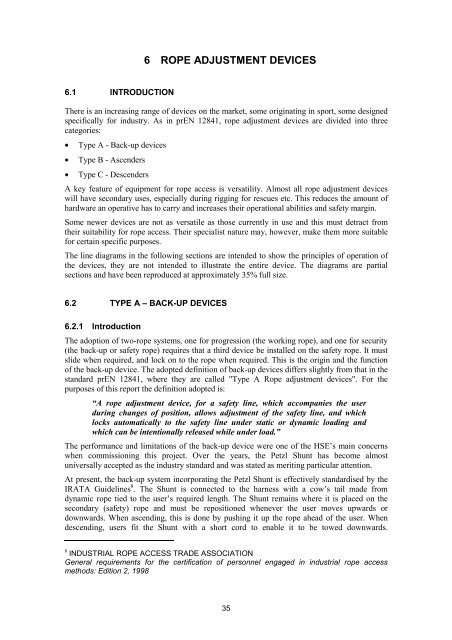HSE: Industrial rope access - investigation into items of personal ...
HSE: Industrial rope access - investigation into items of personal ...
HSE: Industrial rope access - investigation into items of personal ...
Create successful ePaper yourself
Turn your PDF publications into a flip-book with our unique Google optimized e-Paper software.
6.1 INTRODUCTION<br />
6 ROPE ADJUSTMENT DEVICES<br />
There is an increasing range <strong>of</strong> devices on the market, some originating in sport, some designed<br />
specifically for industry. As in prEN 12841, <strong>rope</strong> adjustment devices are divided <strong>into</strong> three<br />
categories:<br />
• Type A - Back-up devices<br />
• Type B - Ascenders<br />
• Type C - Descenders<br />
A key feature <strong>of</strong> equipment for <strong>rope</strong> <strong>access</strong> is versatility. Almost all <strong>rope</strong> adjustment devices<br />
will have secondary uses, especially during rigging for rescues etc. This reduces the amount <strong>of</strong><br />
hardware an operative has to carry and increases their operational abilities and safety margin.<br />
Some newer devices are not as versatile as those currently in use and this must detract from<br />
their suitability for <strong>rope</strong> <strong>access</strong>. Their specialist nature may, however, make them more suitable<br />
for certain specific purposes.<br />
The line diagrams in the following sections are intended to show the principles <strong>of</strong> operation <strong>of</strong><br />
the devices, they are not intended to illustrate the entire device. The diagrams are partial<br />
sections and have been reproduced at approximately 35% full size.<br />
6.2 TYPE A – BACK-UP DEVICES<br />
6.2.1 Introduction<br />
The adoption <strong>of</strong> two-<strong>rope</strong> systems, one for progression (the working <strong>rope</strong>), and one for security<br />
(the back-up or safety <strong>rope</strong>) requires that a third device be installed on the safety <strong>rope</strong>. It must<br />
slide when required, and lock on to the <strong>rope</strong> when required. This is the origin and the function<br />
<strong>of</strong> the back-up device. The adopted definition <strong>of</strong> back-up devices differs slightly from that in the<br />
standard prEN 12841, where they are called "Type A Rope adjustment devices". For the<br />
purposes <strong>of</strong> this report the definition adopted is:<br />
“A <strong>rope</strong> adjustment device, for a safety line, which accompanies the user<br />
during changes <strong>of</strong> position, allows adjustment <strong>of</strong> the safety line, and which<br />
locks automatically to the safety line under static or dynamic loading and<br />
which can be intentionally released while under load.”<br />
The performance and limitations <strong>of</strong> the back-up device were one <strong>of</strong> the <strong>HSE</strong>’s main concerns<br />
when commissioning this project. Over the years, the Petzl Shunt has become almost<br />
universally accepted as the industry standard and was stated as meriting particular attention.<br />
At present, the back-up system incorporating the Petzl Shunt is effectively standardised by the<br />
IRATA Guidelines 8 . The Shunt is connected to the harness with a cow’s tail made from<br />
dynamic <strong>rope</strong> tied to the user’s required length. The Shunt remains where it is placed on the<br />
secondary (safety) <strong>rope</strong> and must be repositioned whenever the user moves upwards or<br />
downwards. When ascending, this is done by pushing it up the <strong>rope</strong> ahead <strong>of</strong> the user. When<br />
descending, users fit the Shunt with a short cord to enable it to be towed downwards.<br />
8 INDUSTRIAL ROPE ACCESS TRADE ASSOCIATION<br />
General requirements for the certification <strong>of</strong> personnel engaged in industrial <strong>rope</strong> <strong>access</strong><br />
methods: Edition 2, 1998<br />
35

















